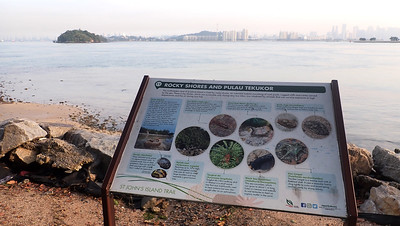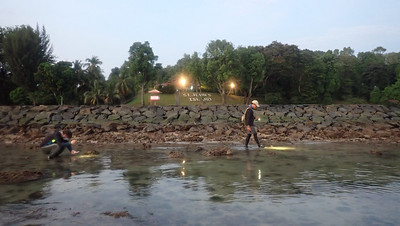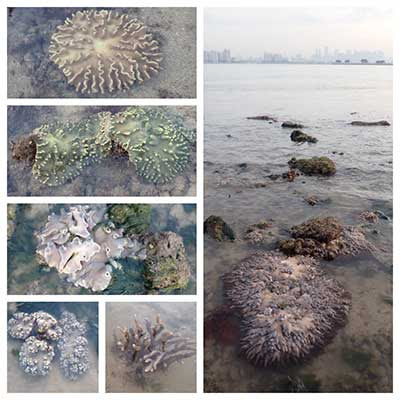Here, there are living rocky shores, reefs, seagrass meadows. As well as rare mangrove trees on the untouched western shore, which is part of the Sisters Islands Marine Park. Things were pretty much similar to our last survey here in Apr 2021.
There are not a lot of hard corals on this shore, but those that were there were doing well. There were several larger Boulder pore corals and boulder-shaped Merulinid corals that were well formed and healthy without dead patches.
Most of the corals are common varieties that are seen on many of our shores: Most were the boulder-shaped varieties. There were some small colonies of Anemone corals, also many healthy Crinkled sandpaper corals. Good to see some small healthy Disk corals. A few had pale edges or were paler than usual, but I didn't see any that were outright bleaching.
I saw a wide variety of medium-sized colonies of leathery soft corals. And a small colony of Leathery sea fan. All were doing well.
I saw many sea anemones of various kinds on the shore. As usual, on the rocky areas many Giant carpet anemones, some Magnificent anemones, Frilly anemones. In the sandy lagoons, Haddon's carpet anemones and one Peachia anemone. For the first time for this location, I noticed Tiny carpet anemone shrimps on one Haddon's carpet anemone. While I didn't see any 'Nemos' (Clown anemonefishes) this time, I did see one Peacocktail anemone shrimp in a Giant carpet anemone.
In the sandy lagoons, I saw many Common sea stars with many small ones - probably males. I also saw some skeletons of the Thick-edged sand dollar, Kelvin spotted a Painted sand star, which less commonly encountered on our Southern shores - more common on our Northern shores. There were also many small Horn-eyed ghost crabs. And many large transparent blobs which might be egg masses of sea slugs or worms. On the rocky area, I saw a Red feather star, a Black phyllid nudibranch. and many small to medium sized Barrel sponges.
I made the pilgrimage past the tip of the northern shore. To pay my respects to the grandmother Nyireh laut tree. She is still very much alive and in fact was producing lots of fruits. Her two daughters nearby are also doing well. On our last survey in Apr 2021, there were two landslides at the cliffs that narrowly missed all three trees. Today, I saw a new landslide on the east-facing cliffs.
It was great to see many small clumps of Tape seagrass, most with fresh green and moderately long leaf blades, growing outside the eastern seawall. Some clumps had rather short leaves though (about 30cm). St John's Island is one of the few shores left that still has long Tape seagrass. There were lush dense growths of Spoon seagrass (with small leaves) outside the seawall, in the eastern lagoons and on sandy areas near the natural cliff area.
St John's Island in the Singapore Blue Plan
The Singapore Blue Plan 2018 highlights the importance of St John's Island to our marine biodiversity.
The cluster of Kusu, Lazarus and St. John's Islands has been recommended by the Singapore Blue Plan 2018 for elevated protection status. The Blue Plan highlights that Lazarus, St. John’s, and Kusu Islands are established sites for coral nurseries as their shoreline offers ideal sheltered areas for growth of corals. Designating these islands as No-fishing Areas can bolster their rehabilitation.
Protecting a larger cluster of islands means zonation plans for use can be implemented to manage tourism and human impacts.
 |
| There are signs all around the island sharing more about the wildlife there. |
Photos by others on this survey
Marcus Ng
James Koh
Richard Kuah
Chay Hoon
Kelvin Yong
Che Cheng Neo
Jonathan Tan
Jianlin Liu
Juria Toramae









